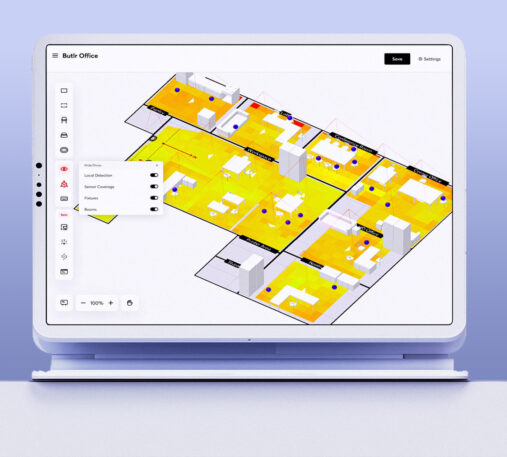Knowing where people are in a building at any moment is valuable information, and a variety of technologies now exist to make it easy to turn a home or office into its own tiny surveillance state.
Using video cameras or simple motion-tracking sensors, these technologies can tell when unneeded energy is being used in empty rooms and where companies are wasting leasable square footage on vacant desks. And in the context of senior care, they can even save lives by alerting health workers if someone has fallen or is unresponsive.
But according to the building technology startup Butlr, doing all this surveillance doesn’t have to mean invading people’s privacy with video cameras in every room. Using sensor technology that detects heat within buildings, Butlr can track building occupancy, space utilization, and the movement of patients in medical facilities.
“At night we can even see somebody sneaking into the kitchen and opening the fridge,” says Honghao Deng, cofounder and CEO of Butlr. “You can see the cold air in the room.”

The use case evolved to something a bit simpler: a low-resolution sensor system that could give the operators of offices and other facilities an accurate but noninvasive idea of how spaces are being utilized.
The pandemic broadened the technology’s applicability, especially in commercial real estate. Companies that suddenly found themselves with millions of square feet of empty offices began to use Butlr’s sensors to better understand everything from when they could turn off lights and air-conditioning on empty floors to when expensive office space could be subleased or eliminated.
And though Butlr is hardly the only company exploring the potential of occupancy tracking—other players include Cisco and Sightcorp—its low-resolution thermal sensing approach gives it some advantages over other more complicated and intrusive technologies.
The implications for tenants and landlords alike are significant. The company recently raised $20 million in a series A funding round, including from the heating and cooling giant Carrier. Zeng says the commercial real estate sector is especially interested in gathering insights about how space is being used. “They can make the decision, for example, next year do I want to expand my office space, do I need to renew office leases or build more offices,” she says.
But the technology isn’t just for big real estate companies trying to optimize their spending. Butlr’s sensors are increasingly being used by the operators of elder care and assisted living facilities. Butlr’s sensors and technology can alert caregivers when a person has stopped moving in an unexpected place, indicating they may have fallen.
Dele Health is a company that uses technology to prevent falls in senior living and care facilities; it recently began using Butlr’s sensors in some of the facilities where it operates.

The data the sensors provide can also help caregivers understand how people are moving within their rooms during the long stretches between nurses doing their rounds, and even detect the conditions that may lead to falls or other medical problems.
“We can start creating patterns and the clinicians start seeing a history of what’s going on,” Hagerty Bonsak says. “They see if a resident seems to be getting up suddenly in the middle of the night or they’re in the bathroom four times in the middle of the night. That movement from a bedroom to a bathroom is a very typical fall situation.”
The idea is for caregivers to adjust patient care or even increase room visits to these fall-prone residents. Hagerty Bonsak says, “We can put measures in place to stop that first fall from happening.”
